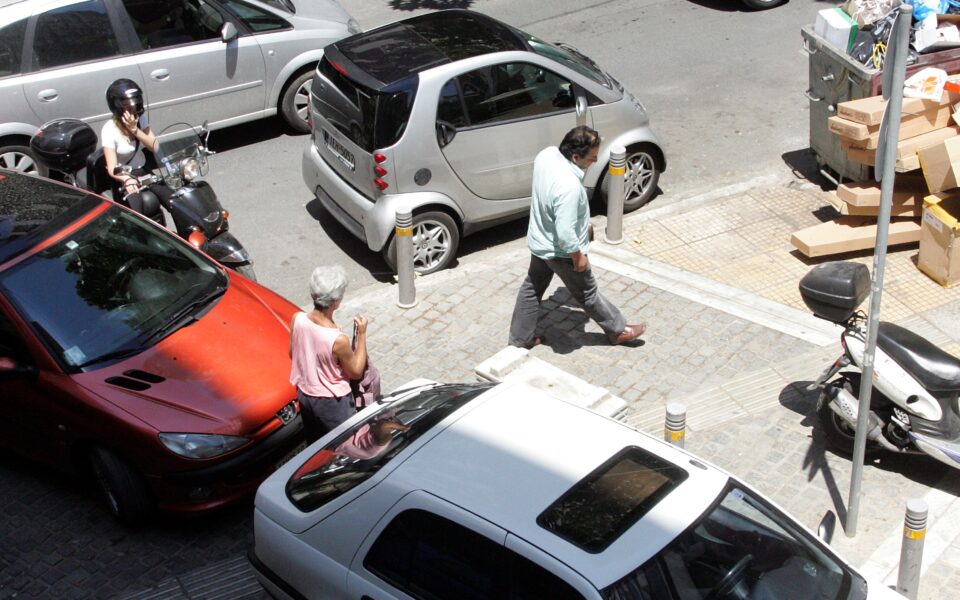Can Athens become a walkable city?
University study explores what it will take to make the Greek capital friendlier to pedestrians and people with mobility problems

Walking in Athens is a risk you take at your own peril. It involves balancing on impossibly narrow pavements, while avoiding broken paving stones and sundry unexpected hurdles. When it comes to parents pushing baby strollers, people in wheelchairs or anyone else with mobility or sight issues, then walking in the Greek capital becomes an obstacle course.
Yet, for cities to be sustainable and functional in the future, they need to become more pedestrian friendly, while simultaneously investing in public transportation and micromobility devices like bicycles, electric scooters etc. The global conversation right now is focused on 15-minute cities, meaning that daily necessities and services are not more than a quarter of an hour away. This is seen as the key to making cities hospitable, free of pollution and energy-climate neutral. Is Athens among the cities that can envision such a future and, if so, how? This question forms the crux of an ambitious project called Walkable Athens that was carried out with contributions from dozens of researchers and scientific associates of the National Technical University of Athens’ (NTUA) Sustainable Mobility Unit, with the help of undergraduate and postgraduate students. The study was delivered to the Athens municipal authority in March this year.
The advantages
“Despite the adverse conditions, Athens also has a lot of positive qualities that could help develop walking as a means of getting around. There is the proximity of many functions, such as schools and supermarkets, for example. There is the mixed use of land/property. It is also worth noting that residents of downtown Athens tend to get around on foot a lot more than in other parts of Attica,” Dr Alexandros Bartzokas-Tsiompras, an urban planner and general coordinator of the Walkable Athens project, tells Kathimerini.
However, the urban infrastructure is well below par, he adds, pointing to the state of the city’s sidewalks, of which at least 75% are narrower than the 2.1-meter limit foreseen by urban planning regulations. Indeed, 40% of Athens’ sidewalks are less than a meter wide, 5% of its streets don’t have any pavements at all, and 57% of the total is in very poor shape.
The project’s researchers documented all of Athens’ streets and presented a structured strategic proposal for improving walkability by 2030.
“One of the main aspects involves increasing pedestrianized streets by 50% in the commercial-historic center, in combination with developing the tram at these locations,” explains the scientific supervisor of the project, NTUA professor Thanos Vlastos.
Special routes
The researchers are proposing the creation of three cultural routes with a total distance of 36 kilometers, offering a different combination of choices. The first will link two important archaeological sites – Plato’s Academy and Aristotle’s Lyceum – and will be prioritized. The second will link the National Archaeological Museum, the Acropolis Museum and the National Museum of Contemporary Art. The third will have the Stavros Niarchos Foundation Cultural Center in Faliro on Athens’ southern coast at one end and the Athens Concert Hall at the other, with the Stegi Cultural Center, the National Museum of Contemporary Art, the Goulandris Museum, the Byzantine Museum and the National Gallery in between.
“It is important for there to be information signs along the route. Visitors come to Athens and expect to see its history, just as much as residents want to learn about their city. Our streets have no such information, unfortunately,” notes Vlastos.
Another proposal concerns the creation of 15 “green” routes with a total length of 76.5 kilometers that will also entail increasing the number of trees in central Athens by 50%. The key aim is to ensure that every apartment block has access to a green street. “We’re talking about routes with more greenery, with more quiet and with comfortable sidewalks. The aim is for every resident to be within 500 meters of such a route,” he adds.
Walkable Athens’ researchers also approached the city as a whole, looking beyond earlier interventions, which tended to be focused solely on the very center and on serving tourism. “We often dress up the window and sweep the social inequalities under the rug. For example, the state of Athens’ fourth district, which comprises Kolonos and Sepolia, among others, is much worse than other parts. There, 75% of the sidewalks are in very poor condition and are so narrow that you can’t even get to the bus stops,” notes Bartzokas-Tsiompras.
More sidewalks
So what can be done for such neighborhoods. “To begin with, we need to broaden and fix the sidewalks. Is there room? There is if we get rid of parking on both sides of the street,” says the project’s coordinator.
“When sidewalks are too narrow or covered in obstacles, pedestrians have no other choice than to walk in the middle of the street. Since cars and motorcycles park on the pavements and the state is unable to prevent them, pedestrians are forced into the road. It happens all too often in Athens. The state should reduce the speed limit inside the city to 30 or even 20 km/h. There has been a significant increase in such go-slow streets all over European cities,” says Vlastos.
‘We often dress up the window and sweep the social inequalities under the rug’
The study sets a goal of a 50% increase in the number of single-lane, no-parking streets and doubling the number of streets with a 30 km/h speed limit. According to the record made by the researchers, at least half of Athens’ streets could be slow streets. This would also contribute to reducing the number of traffic accidents involving cyclists and pedestrians – Athens has one of the highest rates of deadly traffic accidents in Europe – with the experts setting a target of 50% in this direction.
“We need to give every resident of Athens the ability to get to their destination or to the public transportation stop they want on foot, while at the same time revising the sense of neighborhood and community in these areas. This is why it is important that buildings continue to host multiple uses, such as small shops and businesses,” notes Vlastos.
To this end, the Walkable Athens team has put forward a combination of interventions that have worked in other parts of the world. “By abolishing one out of every three or four parking spaces and replacing it with a tree, we can give shade to pedestrians and make room to expand the sidewalk. There is also the option of parklets or pocket parks that offer a place to rest and connect with neighbors, which can also be created by abolishing a few parking spaces or broadening sidewalks,” he adds.
Special attention has been paid to the safety of youngsters getting to and from school, with the report proposing slow streets for a radius of 250 meters around all schools and measures to encourage parents driving their kids to drop them off outside this perimeter rather than at the entrance, where accidents are more likely. By adopting this measure alone, dozens of neighborhoods hosting schools would become go-slow zones.
In a similar vein, the study recommends the introduction of streets where children can play safely, a measure that has already been adopted in many parts of Europe and harks back to older times. “The pilot phase of the proposal foresees the closure of certain streets for two or three hours a day, two days a week, at seven locations. It is so important for youngsters to get an idea of how things could be different,” says Vlastos.
The big question that obviously arises with all these proposals, is what residents are expected to do with their cars. “There are no magical solutions,” notes Bartzokas-Tsiompras. “The only real solution is reducing car use. People need to walk and this is also a matter of public health. It’s an aspect of the issue that is not part of the conversation right now, but it is important. There is also the fact that many residents keep their cars parked for most of the time, while many even pay a lot for the privilege. Why?”
Bartzokas-Tsiompras argues that their needs can be covered by a combination of walking and using micromobility devices and/or public transportation. “We need to start thinking about sharing more as well; sharing scooters, bicycles and cars,” he says.
But can all this really happen in Athens? “Of course things can change; we’ve seen so many cities do it,” says Bartzokas-Tsiompras.
“The heart of the matter lies in us falling back in love with our city. What matters is the relationship residents have with their city, with its people, with its history and with its identity,” adds Vlastos.





